If Mies van der Rohe’s seminal yet sadly unbuilt Brick Country House—designed in 1923 as an abstract composition of orthogonal planes extending far beyond the volumes they enclose—had been rendered in stone, it might look like Enso House II. This complex of parallel and perpendicular walls, made of locally quarried Mexican cantera, stretches out onto a high desert plateau north of San Miguel de Allende. Its architect, 42-year-old Rogelio Bores, founding principal and creative director of HW Studio, based in Morelia, readily concedes the similarity, saying with a laugh, “It’s the son of Mies and Fred Flintstone.”
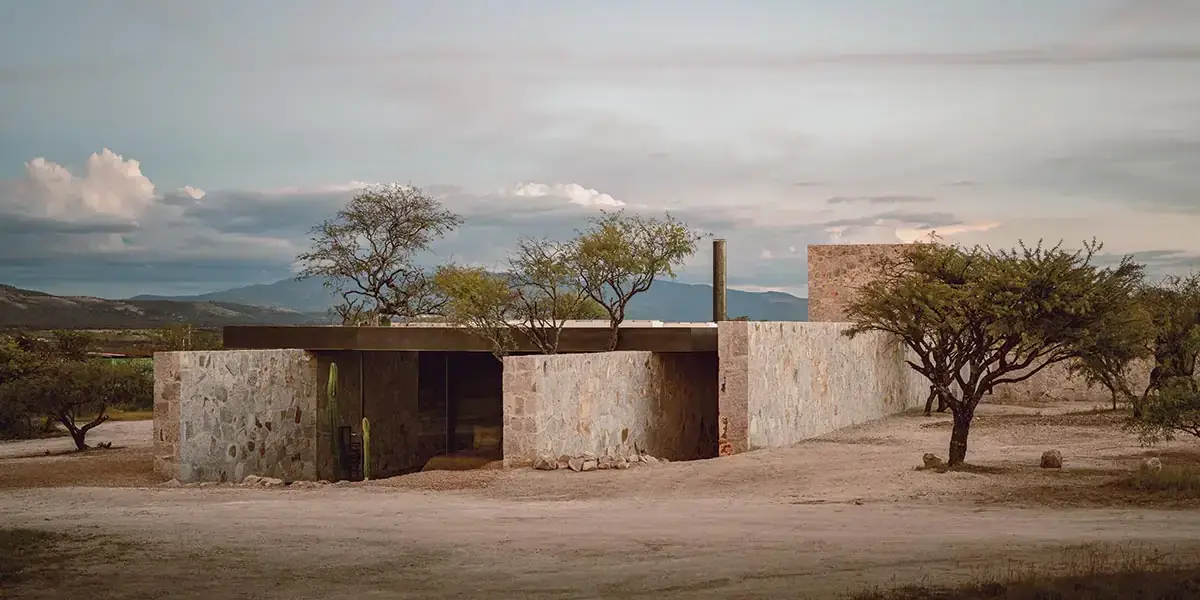
1
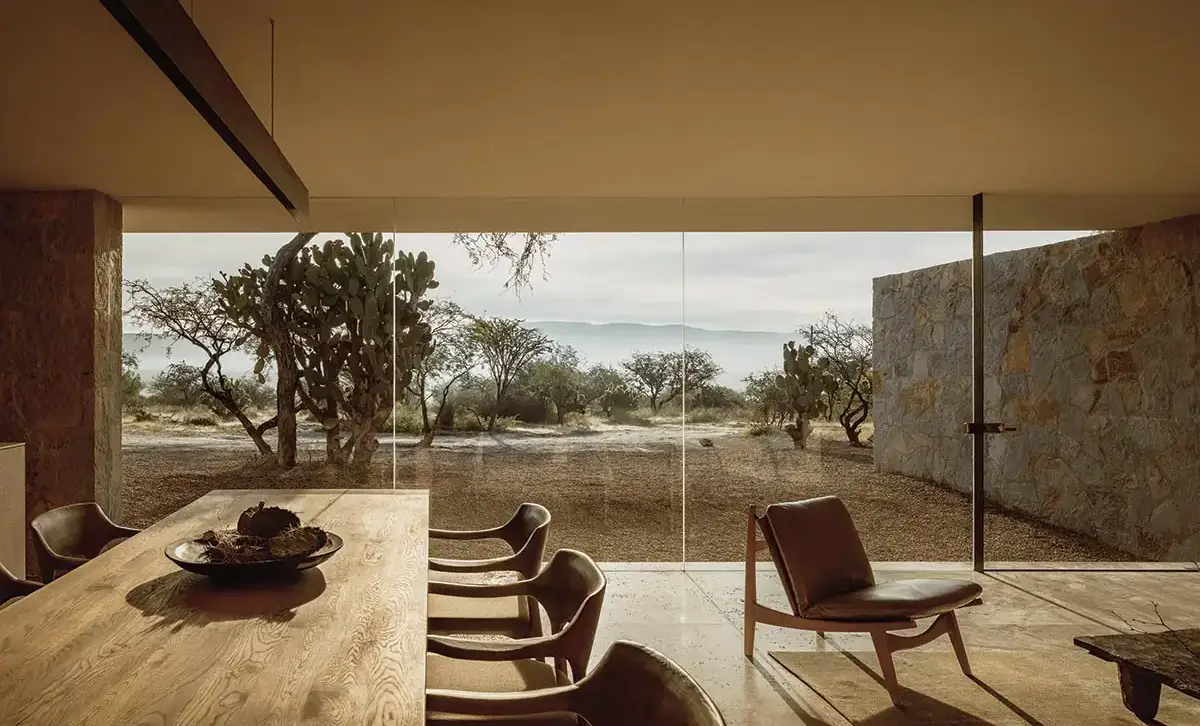
2
The cantera stone walls, with hues that match those of the desert (1), punctuate the landscape and define the free-flowing interior, including the main living space (2 & 3). Photos © César Béjar, click to enlarge.
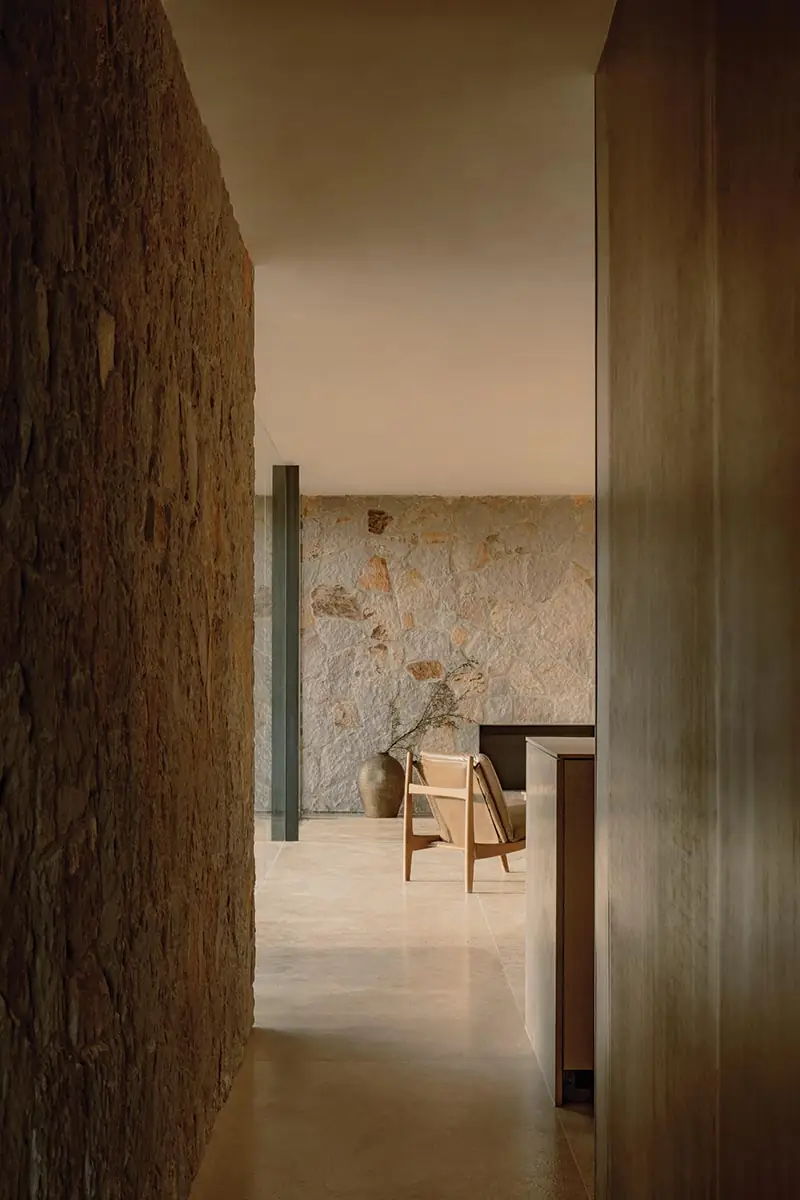
3
Bores designed the 2,100-square-foot compound, completed last year at a cost of $300,000, for Cem Turgu and Adriana Alegría, a young married couple, she from Mexico, he from Turkey. Both work in the oil industry as engineers. They met in South Africa, and, after living in many parts of the world, decided to settle in a secluded location in the northern central highlands of Guanajuato state. Their needs were basic: a modest dwelling with one bedroom and an office. They had initially hired Bores for a more ambitious project, Enso House I, but the Covid pandemic and its uncertainties caused them to rethink their plans and downsize. “The name Enso,” says the architect, “derives from a Buddhist term for an imperfect handmade circle that symbolizes the fullness of the simple.”
Bores takes a decidedly spiritual—you might say mystical—approach to design, which informed the name he gave to his architectural practice, HW Studio. “The letter H in Spanish has no sound,” he explains. “It is the graphic representation of silence. The W refers to the Japanese tea ceremony Wabi-Cha, from which several Japanese aesthetic principles, such as Wabi-Sabi, are derived.” He begins every project by contemplating what he calls “the three variables of architecture: place, user, and designer.” To learn about place, he and his team make multiple site visits to “listen to its soft and particular murmurs.” He gets to know his clients through a personality profile test, administered by a neuropsychologist who asks them to assess themselves for various traits such as self-discipline and extroversion. Then, in his role as designer, Bores meditates silently on the information gathered. “Until we have completed these three tasks, we try not to think about architecture, and let ourselves be carried along by the process, like a leaf on a river.”
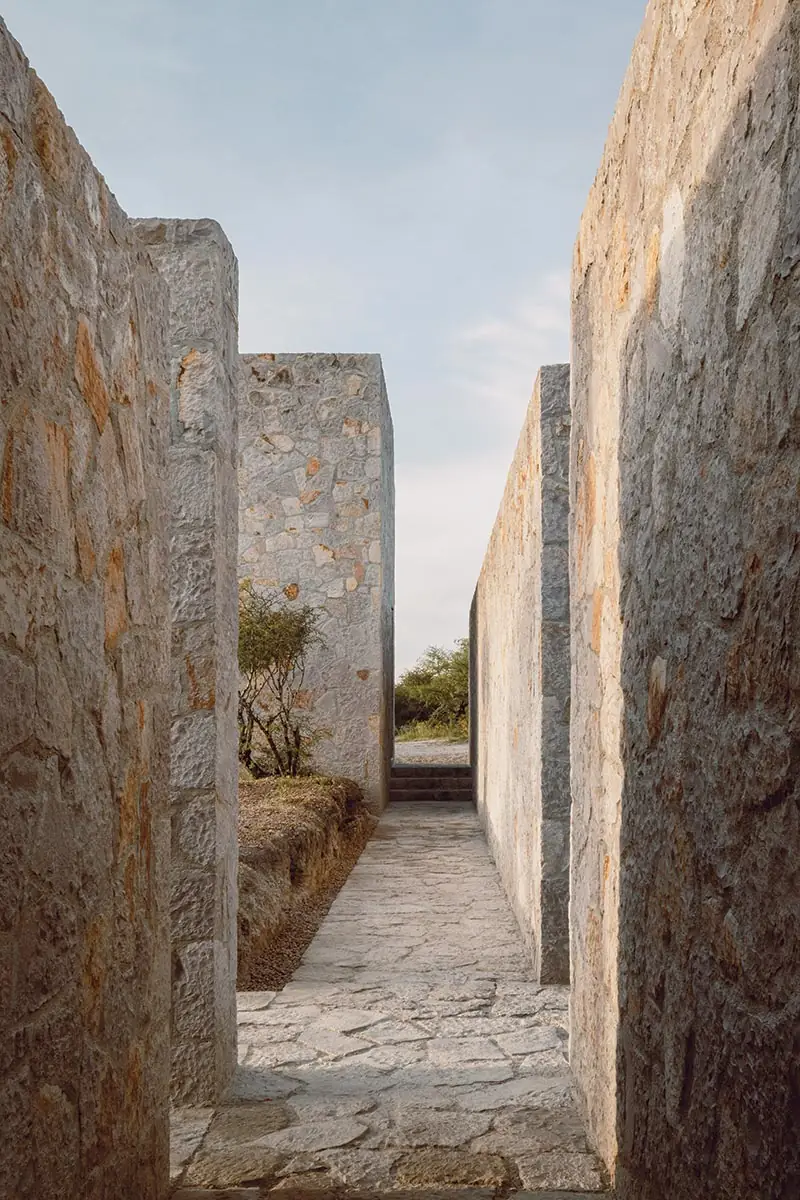
Circulation paths follow the stone walls’ cruciform configuration. Photo © César Béjar
These elaborate predesign rituals may seem a bit much, but you can’t argue with the rigorous results. Bores organized the plan as a cruciform of long stone walls, with parallel paths for circulation, dividing the site into four quadrants. Each serves a single purpose: parking area, entry garden, home, and office. The house is a low, rectangular volume whose flat concrete roof cantilevers to provide protection from the desert sun. Inside, a central service core, containing a bath and closet, separates the bedroom from a living and dining area with an open kitchen. This room’s east-facing exterior wall of butt-jointed glass looks out to a mountain about six miles away, framed by acacia shrubs in the middle distance and a prickly pear cactus in the foreground. The view to the north from the bedroom, though less dramatic, is expansive and serene. A smaller, more vertical outbuilding, which serves as an office, with mechanical space above, punctuates the insistent horizontality of both the architectural composition and the surrounding landscape. “The intent here,” says Bores, “was to flirt with the iconic volumes of the Santa Brígida mine,” a local landmark of three tall stone pyramids rising from a plinth in nearby Mineral de Pozos.
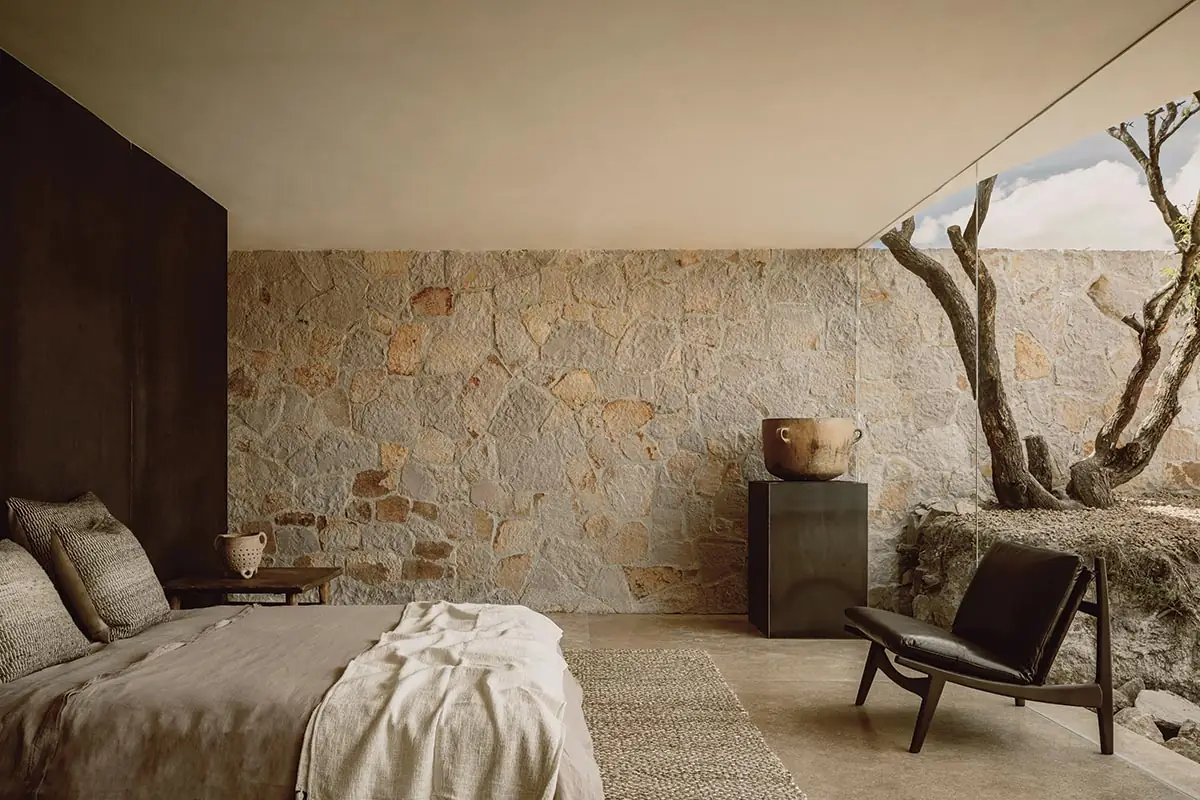
Butt-jointed glass in the bedroom and elsewhere blurs the distinction between indoors and out. Photo © César Béjar
Despite its modest size and program, the complex has a strong but subtle monumentality. This is due primarily to the extensive and massive cantera walls, which are 20 inches thick and approximately 8½ feet high, on average, and total almost 500 feet in length. Their variegated hues range from pale warm gray to ochre and terra-cotta. Travertine flooring and the weathering steel cladding of the service core (with a matching metallic laminate for cabinetry) adhere to this limited palette. These are the colors of the Mexican high desert, and their rich yet muted tones and textures provide an organic counterpoint to the strict orthogonal geometry of the architectural plan and massing.
“In this area, stone is an element deeply rooted as a form of cultural expression,” says Bores. As a result, experienced masons are readily available. They cut the cantera by hand and determined the arrangement in which the pieces were laid. “It’s like a Tetris game,” says the architect. The mortar is brushed to recess it slightly, making it less visible. The walls disturb the site as little as possible and look as though they have always been there. The effect, according to Bores, is like “an ancient monastery, framing the landscape but at the same time forming a natural part of it.”
The architect has detailed the house with elegance and precision. Frameless glass intersects seamlessly with cantera walls, travertine floors, and concrete slab ceilings. Asked where he acquired the technical skills to accomplish this, Bores cites lessons learned while earning his graduate degree at Universidad Europea in Valencia, Spain. There he studied with several masters of materiality, including Fran Silvestre and Alvaro Siza. He also credits the skilled craftsmen, whom he supervised carefully in weekly site visits. “However,” he adds, “I do not rule out that the meticulous obsession of my surgeon father had something to do with it.”
Click plan to enlarge
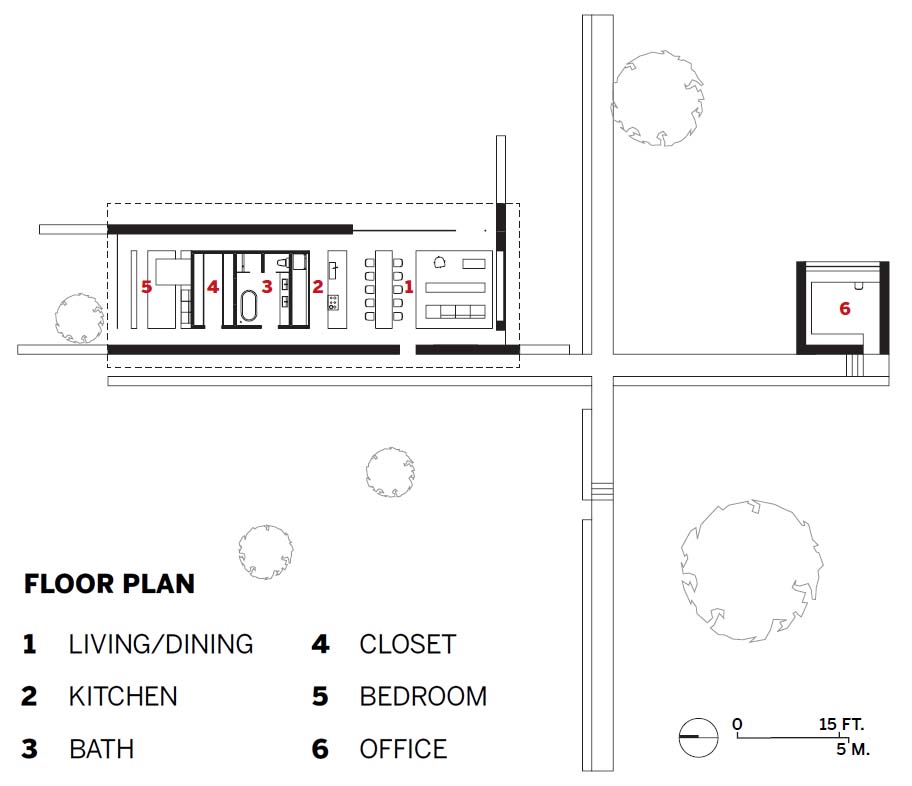
Credits
Architect:
HW Studio — Rogelio Vallejo Bores, CEO and senior architect; Oscar Didier Ascencio Castro, Nik Zaret Cervantes Ordaz, architects
Consultants:
Constructora ARGA (structural); Mur Studio (kitchen)
General Contractor:
Constructora ARGA
Clients:
Cem Turgu and Adriana Alegría
Size:
2,100 square feet
Cost:
$300,000 (construction)
Completion Date:
November 2022
Sources
Precast Concrete:
Concretos ABC
Tempered Glass:
La Unidad
Window and Door Frames:
Cuprum
Hardware:
ASSA ABLOY
Countertops:
Cosentino
Chairs and Tables:
NAMUH STUDIO
Lighting:
Illuminación Megamex, Tecnolite
Lighting Controls:
Bticino
Plumbing Fixtures:
UREA, Interceramic




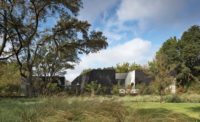
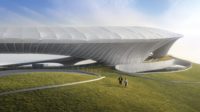
Post a comment to this article
Report Abusive Comment